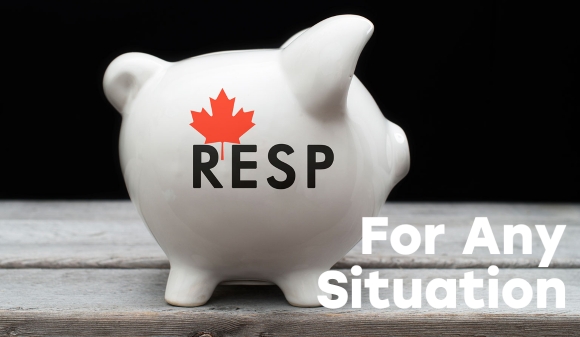RESPs For Any Situation

 Most experienced home cooks know that single-use appliances are more trouble than they’re worth. Unless you’ve got a bunch of already-peeled garlic cloves and very small tomatoes, you’re going to have to do a lot of work to get the ingredients ready to use that slappy thing, so you may as well chop away with a knife you can use for all sorts of jobs.
Most experienced home cooks know that single-use appliances are more trouble than they’re worth. Unless you’ve got a bunch of already-peeled garlic cloves and very small tomatoes, you’re going to have to do a lot of work to get the ingredients ready to use that slappy thing, so you may as well chop away with a knife you can use for all sorts of jobs.
Registered Education Savings Plans (RESPs) can sometimes feel like a single-use tool. Still, I assure you they are much more like a Swiss Army Knife than they are a Slap-Chop: multi-purpose, a bit complex, but—once figured out—useful for lots of different kinds of people in lots of different kinds of circumstances.
Here’s a brief refresher on Registered Education Savings Plan basics:
An RESP is a container, much like a Registered Retirement Savings Plan (RRSP) or a Tax-Free Savings Account (TFSA). The container tells the Canada Revenue Agency (CRA) how to treat the money inside it, and which can be invested however you’d like: cash, GICs, mutual funds, ETFs, stocks, bonds...almost anything you can invest in can be owned inside an RESP.
The person who owns the account is the “subscriber”, while the person whose education we’re saving for is the “beneficiary”. You can contribute up to $50,000 per beneficiary to an RESP. For every dollar invested, the government gives you at least 20 cents in Canada Education Savings Grant, up to a maximum of $500 in any given calendar year and $7,200 per beneficiary. There are some extra rules about making up for missed contribution years as well.
Your contributions, anything deposited by the government, and any investment income earned are considered two separate pots of money, even though you see them as a single balance. When the time comes to withdraw from the RESP, each pot has its own rules: your contributions can be withdrawn tax-free, government grants can be withdrawn only if the beneficiary is enrolled in an eligible post-secondary program, and investment income can be withdrawn and taxed in the beneficiary’s hands if they’re enrolled in an eligible program; otherwise, investment income is taxed in the subscriber’s hands, along with an extra 20% penalty tax.
There’s much more to RESPs than three short paragraphs can hope to explain, but that’s the gist. So how can you, in whatever circumstances you find yourself in, use this versatile tool best?
If you have a low income and little ability to save:
You’re in this category if you’ve ever said something like, “We don’t have enough money to save for our kid’s education. What’s the point of an RESP?”
Open an RESP anyway. Once the beneficiary has a Social Insurance Number, go to www.smartsaver.org to start your application, get connected to a local financial institution that offers RESPs with no fees for setting it up and no annual minimum contribution amount.
Suppose your income is below the threshold (which is adjusted each year and depends on the number of children in your family). In that case, you can receive up to $2,000 per beneficiary from the government’s Canada Learning Bond program...even if you never contribute a dime of your own money.
If you do contribute your own money, you get that 20 cents back on every dollar that everyone else gets from the Canada Education Savings Grant, as well as an additional 10 to 20 cents in “Additional” CESG, depending on your income.
If you have a moderate income and want to get the most bang for your buck:
You’re in this category if you’ve ever said something like: “I just want to make sure I get all the grant money my kid is entitled to but can’t stretch my savings any further than that”.
This is just math: contribute $2,115 per year for 17 years. If you can save a bit more than that and want compounding to work in your favour, contribute $2,500 per year for 14 years, and $1,000 for one final year. Either way, you will have contributed $36,000 of your own money and received at least $7,200 from the government. Along with whatever investment income the account earned along the way, you’ve given the beneficiary a tremendous leg up on the cost of post-secondary schooling and should be incredibly proud.
If you have a high income and/or strong values around paying for all the costs of post-secondary:
You’re in this category if you’ve ever said something like: “I just want to make sure my money’s being allocated to the right goals”, or “RESPs are too complicated, I’m just going to use a non-registered account instead”.
Too often, people in your circumstances are given the cookie-cutter, default advice designed to get the most grant money for the least contribution (see above) without considering either your capacity to save or your education goals.
Instead of aiming to maximize the grants your beneficiary receives, someone in your circumstances should set their goals higher: maximize both the grants and your contributions. This means that you want to work out the maximum amount to contribute each year to reach the $7,200 in lifetime grants and the $50,000 in lifetime contributions.
Again, this is just math: contribute somewhere between $1,416 and $3,333 per year, which will have your RESP and grants completely maximized by the time the beneficiary is 15 (the higher amount) and 17 (the lower amount). The higher the amount, the more time you’ll give your investment income to compound. You’ll end up contributing $16,000 more to the RESP than you would if you just followed the default advice—not too shabby!
Incidentally, the tax-deferred and transferred nature of investment income earned in an RESP starts to become important for people like you. If you’re tempted to use a non-registered investment account for education savings and skip the RESP altogether, remember that you’re likely in a higher tax bracket than your beneficiary will be while they’re in school.
This is important because investment income earned inside the RESP is not taxed every year like it would be in a non-registered account, leaving more money to grow undisturbed. Further, suppose the beneficiary is in an eligible program when the money is withdrawn (and there are literally thousands to choose from, with plenty of alternatives to a four-year university degree). In that case, the investment income is taxed in their hands, not yours!
If you have more than $50,000 to contribute to an RESP all at once:
You probably know if you’re in this category without a helpful quote.
This may sound like shocking advice, but if the beneficiary is years away from needing the money, you might want to consider depositing it all in a single year, getting your $500 in grant money, and leaving the rest of it on the table (because you will have reached the lifetime contribution limit, so won’t be able to make the required annual contribution to get the 20% grant).
Choosing whether to do this or not depends heavily on what rate of return your investments earn, the length of time before the money is needed, and what you’d do with the money if you didn’t use it for this. There are smarter minds than mine working away to discover the optimal circumstances for this strategy to be worth it, but here’s an example of the thought process:
If the beneficiary is born this year and you can either contribute $50,000 to the RESP this year or $3,333 per year over the next 15 years, and you are reasonably sure that you’ll earn more than 2.6% on your investments, you should contribute the $50,000 even though you’ll only get $500 in grant money and lose out on the other $6,700.
Like anything else in the financial world, a Registered Education Savings Plan is just a tool you can use to reach your personal goals. Paying close attention to your circumstances will help you use this versatile tool in the right way.
Sandi Martin is a partner and financial planner at Spring Plans, a national advice-only financial planning firm.


